Blog about successful marketing strategies in russia
The Digital Frontier: How DOOH is Shaping the Future of Advertising in Russia


MEDIA BUYING
Share this Post
The past year of 2023 has characterized itself as a time of new challenges and opportunities, especially in the Russian market - changes in the internal structure of segments, the transition to Russian digital services, and the emergence of new companies to replace those that have left, plus artificial intelligence. If in 2022 many analysts tried to define the boundaries of market "decline" due to the sanctions policy and its consequences, now the forecasts are focused on the upcoming development in all areas.
Besides, one of the most promising segments in Russia is outdoor advertising. It was predicted to have the slightest negative changes, after which further growth comes. Was it really so and what to focus on in 2024? More details in our article.
OOH has lost advertising volume to DOOH
In 2023, the volume of outdoor advertising in Russia grew by 46%, mainly due to DOOH advertising, which has become more attractive to brands for several reasons. Plus, the technical inventory in the industry, which has been taking place since the beginning of 2022, has opened up new formats and tools for advertisers.
It is the DOOH segment that is driving all of the growth in outdoor advertising, while OOH has only been able to recover to 2019 levels. However, the horizons of DOOH advertising look more promising. In 2024, experts predict a market volume of more than $200 million. This is the highest figure since 2008. Nevertheless, it is quite realistic, since the DOOH segment is developing at a rapid pace.
A key factor in this growth is the evolution of advertising infrastructures. Due to the larger area of one DOOH screen and the cost of placement on it (note - equal to 10 OOH screens), there is a general trend where the number of physical advertising structures is decreasing and the amount of advertising inventory is increasing. A screen allows you to show a lot more advertising messages than traditional formats. In addition, it is much faster to place an advert on a screen than to print and install a billboard. This transformation increases commercial exposure and sales potential.
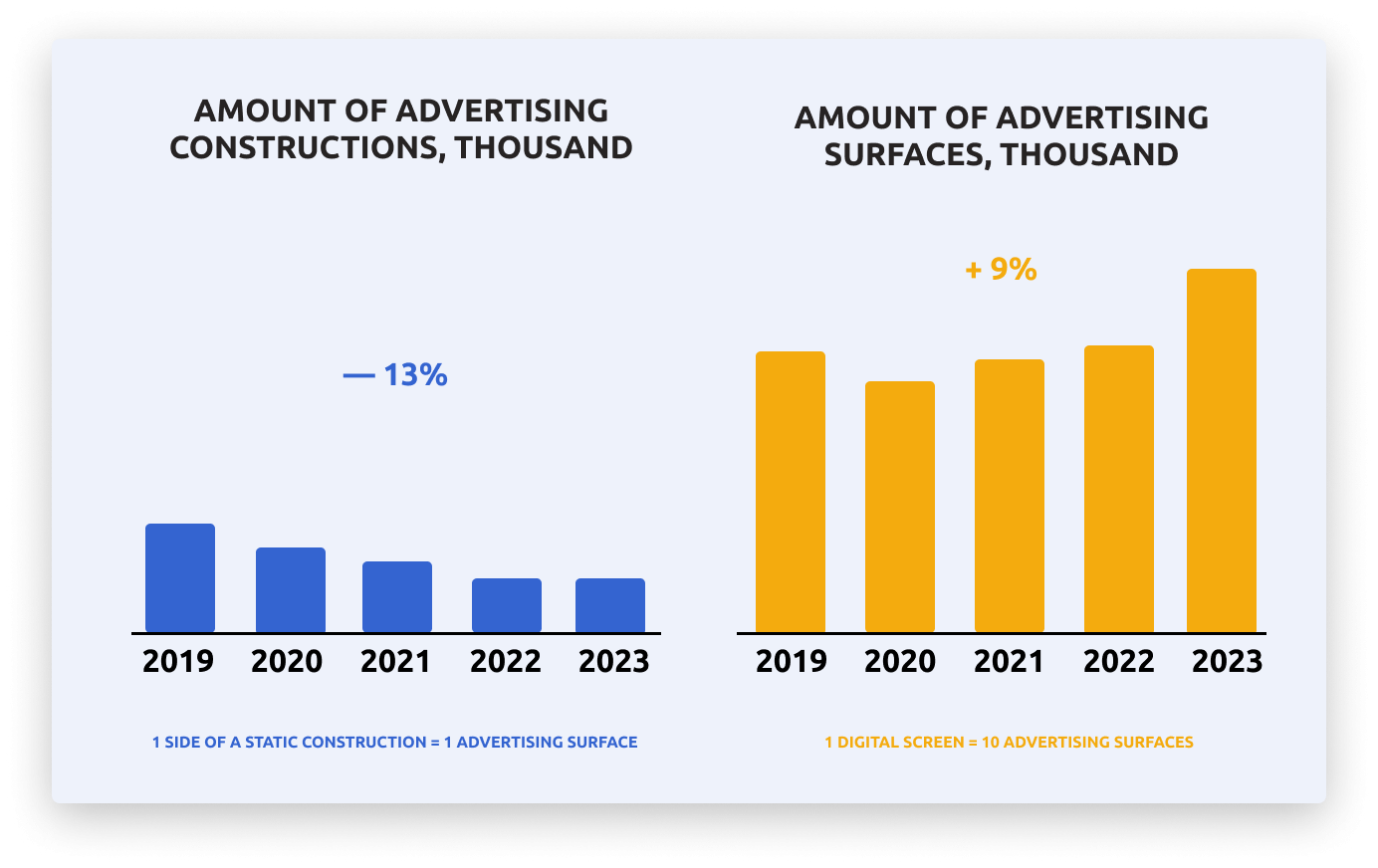
Source: Admetrix
The share of digital outdoor advertising in Moscow has doubled over the past few years and equals 67% of the total number of advertising facilities. In St. Petersburg, the volume is slightly lower and amounts to 43%. At the same time, a gradual digitalization of the segment happens in the regions. For example, Ekaterinburg is planning to launch the largest media facade in Russia (note: the panel size is 10,000 square meters). This was expected, as the budgets for DOOH advertising there exceeded the purchase of OOH facilities in 2023. The same applies to Nizhny Novgorod (DOOH 80%, OOH 20%), Samara (DOOH 68%, OOH 32%), Kazan (DOOH 54%, OOH 46%). The average regional spend of advertisers on digital screens was more than 50%.
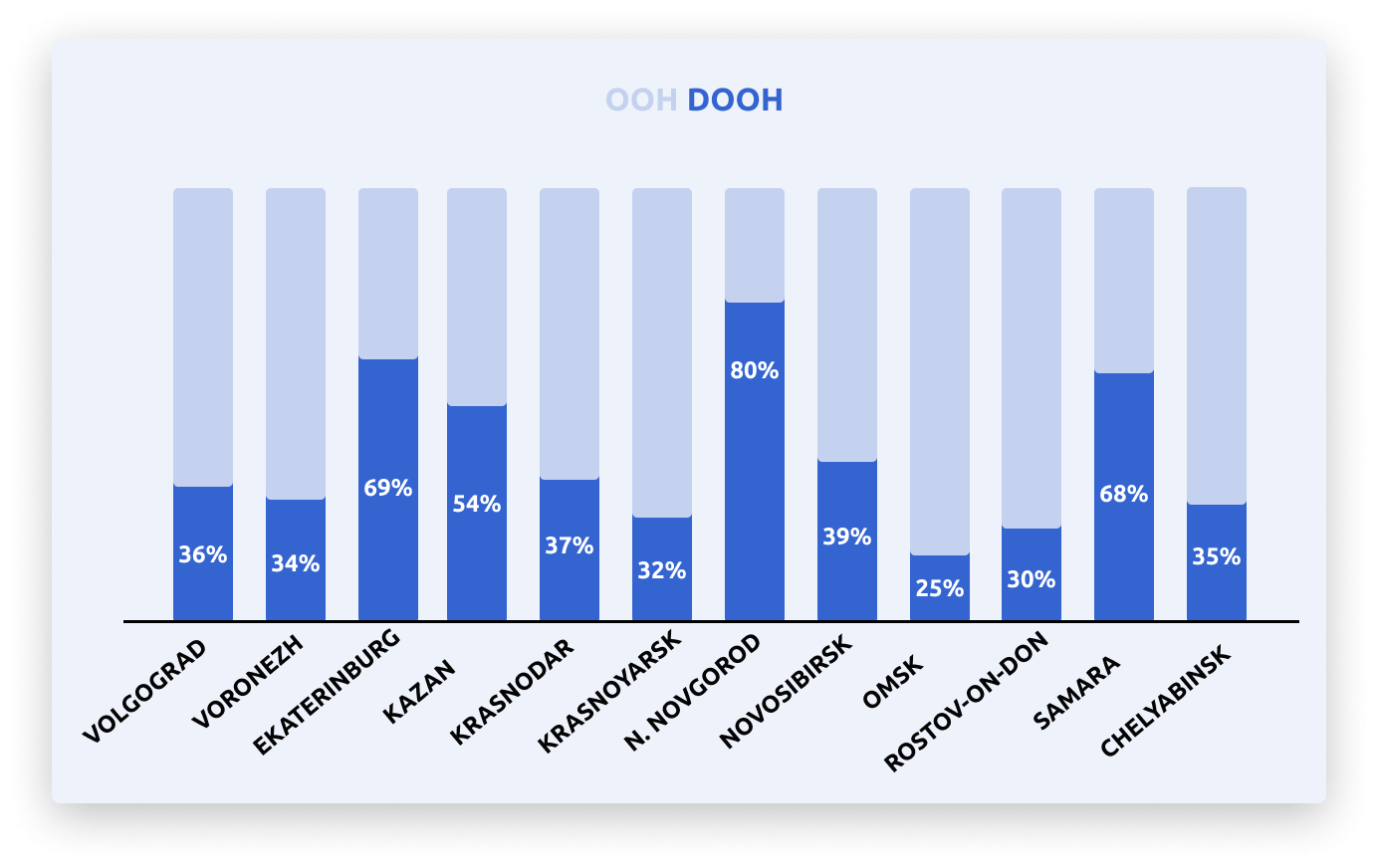
Source: Admetrix
Despite all the dynamic changes, the reach of outdoor advertising has remained large-scale and stable over the past two years. The demographic group consists mostly of men and women aged 25-64, representing 93% of the Russian population. This only emphasizes the huge influence of the Out-of-Home segment as a whole and provides many brands with a significant opportunity.
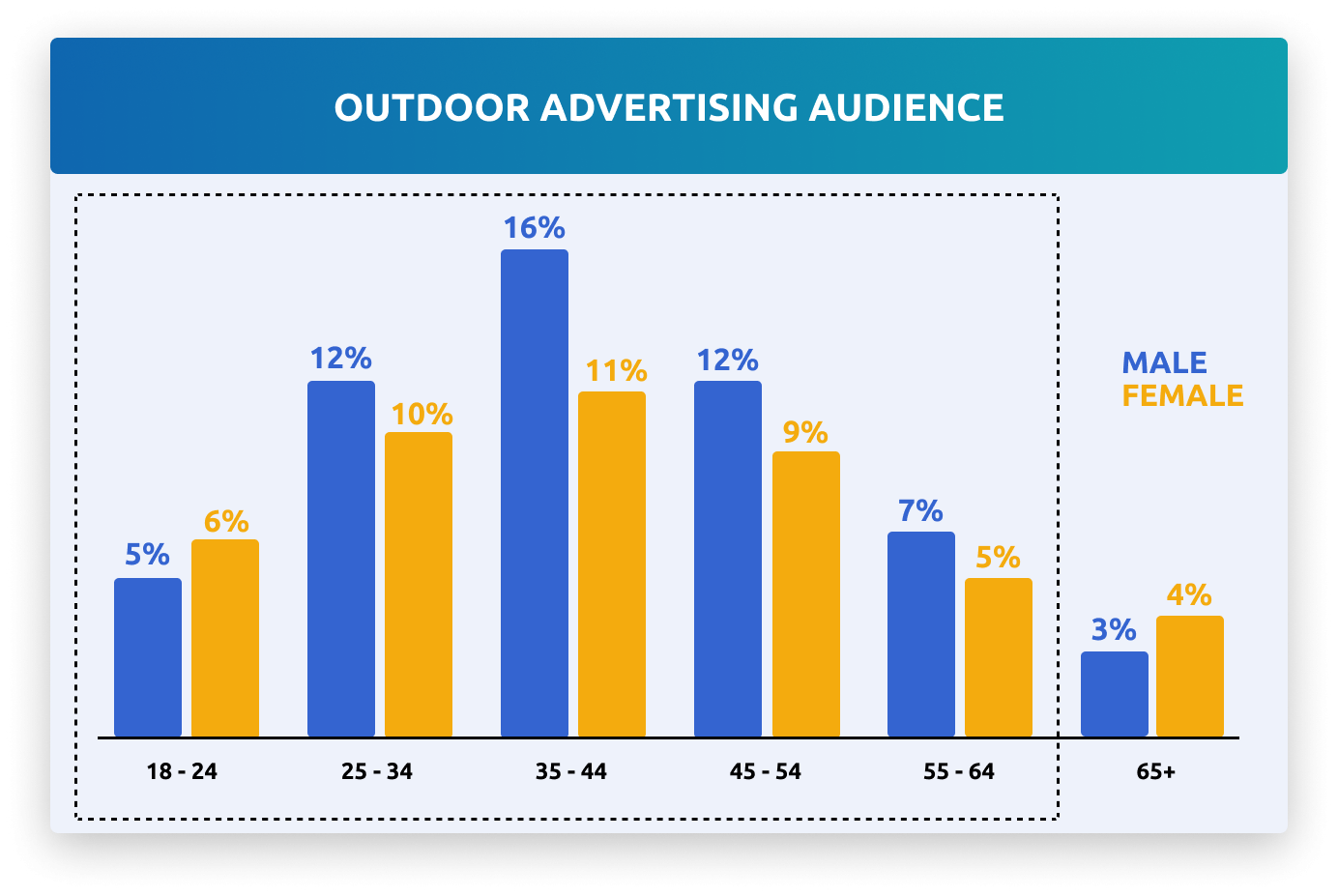
Source: Admetrix
Analyzing the advertiser categories, it can be noted that 'Real Estate’ is the largest sector investing in outdoor advertising, while 'Internet Services' leads the way in digital. By the way, the largest advertiser in terms of outdoor advertising spending is Yandex (note - Russian search engine and online services).
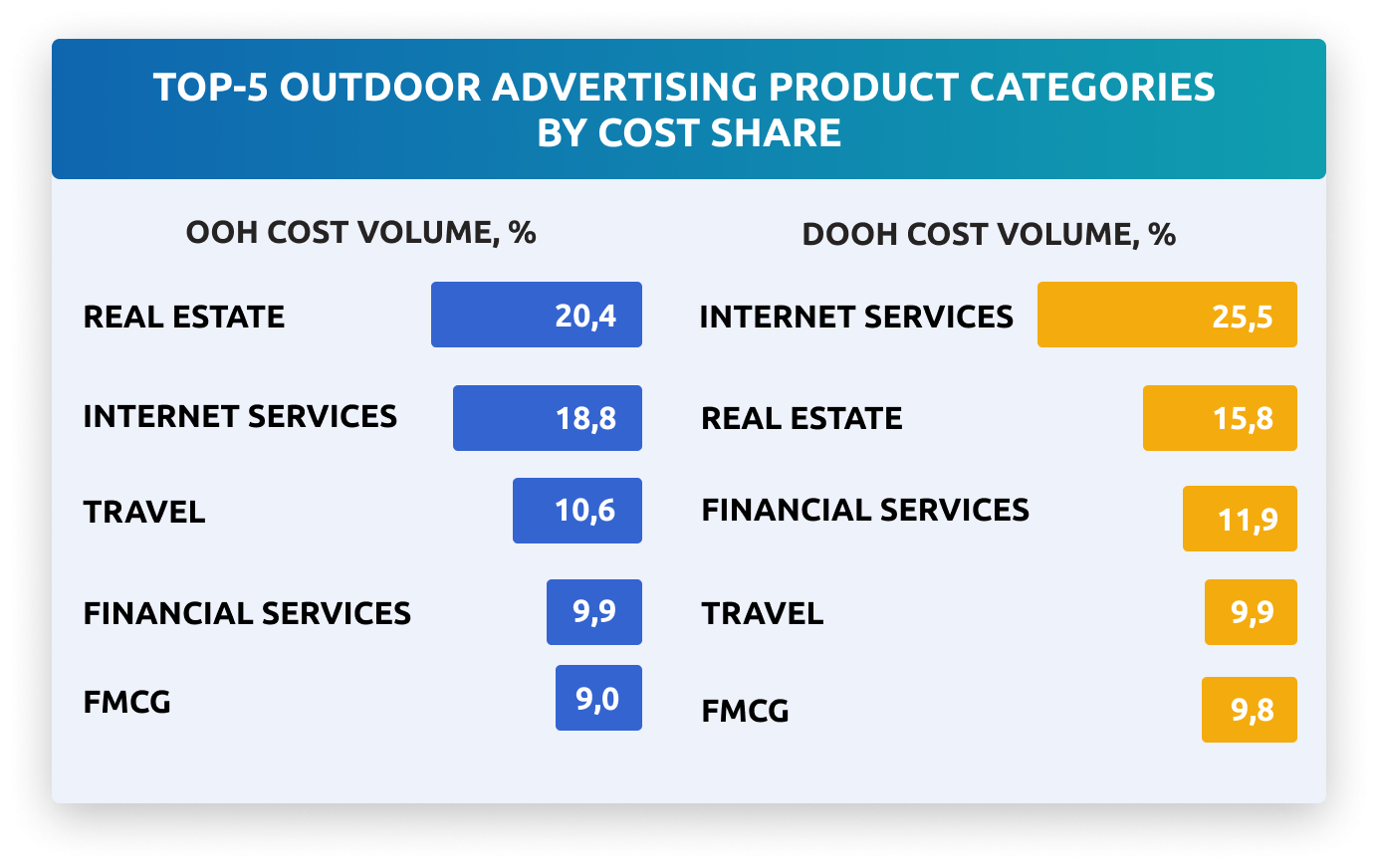
Source: Admetrix
In addition, foreign companies are showing great interest in digital media in Russia. Konstantin Major, CEO of the Russian media holding Maer Group, said in his interview to Rossiyskaya Gazeta that their holding has already attracted some Chinese clients with its solutions in the DOOH segment. Among them were such brands as Omoda, Exeed, Gac, Chery, Haier, Aliexpress, and others. RMAA also cooperates with Chinese clients in the segment and beyond. In 2023, we have successfully conducted DOOH campaigns for brands near and far. This year, projects from overseas companies are really up and coming.
In general, the outdoor advertising segment in Russia is quite ‘monopolistic’. Here, 56% of all media belong to the five leading outdoor advertising operators: Russ (38.8%), Rim Mediagroup (6.8%), Designmaster (4.2%), Dream (3%), and Poster (2.8%). The remaining operators may vary in the format of their service delivery. It is difficult to say how and where the budget for outdoor advertising can be spent more effectively. Each project is different. Somewhere the purchase price will be more expensive, but the options are much better, and vice versa.
New Outdoor and Indoor digital formats
Apart from the active use of digital facades and screens, new forms of DOOH are emerging in Russia, including indoor.
VK Holding placed a New Year's Outdoor installation at VDNKH (note - the largest exhibition center in Russia). It contained two types of digital media: a cube and a construction of LED panels in the shape of a Christmas tree. VK Clips, guests' wishes tagged #ChristmasTreeVK, and entertainment content were broadcasted on all surfaces of the tree. The multimedia cube could be used more interactively: a user could take part in a quiz about Russia's achievements, create content with different visual elements, or see a festive animation with the VK hero, the cat Peach. Each activity was accessible using QR codes.
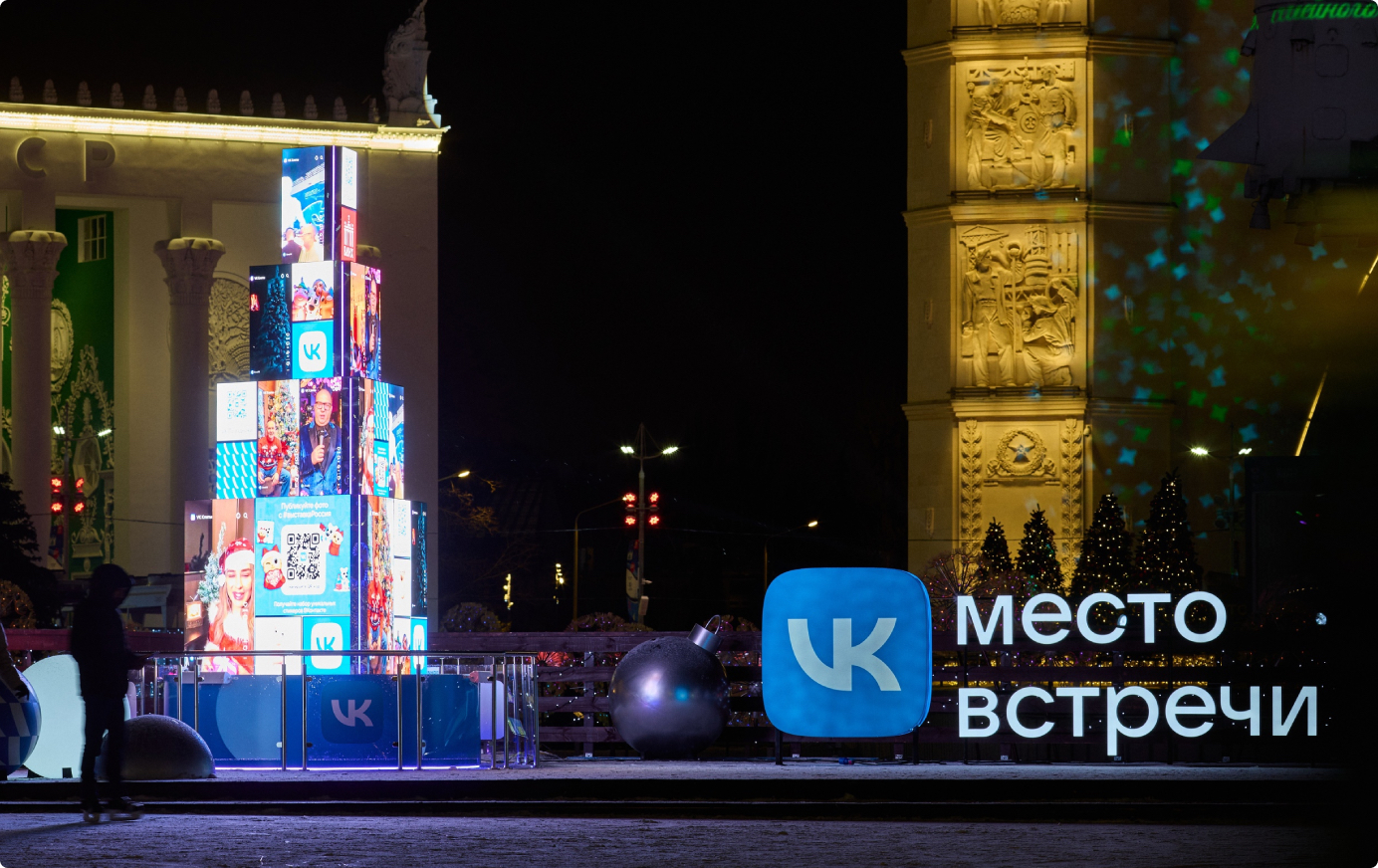
Source: official VK Holidays Community
The mobile operator MTS has already used non-standard solutions many times, including inside various buildings. In early 2023, the brand launched a digital art installation in the Moscow metro using a visualization of the idea of high-speed data transmission over a mobile network. The digital image was broadcast on the surface of a magic flying carpet sized 4x2.5 meters and made of a curved LED screen. The visuals of the campaign were created using AI, with images of MTS entertainment services integrated into the content.

Source: MTS
The brand did not stop there. At the beginning of 2024, MTS installed a branded zone of 64 holographic fans creating a visual impression of 3D 'flying' content in the Afimall shopping center (note - Moscow City business complex), Each visitor of the shopping center had an opportunity to control the rollers on the screen without contact using Leap Motion sensors.
The main goal of the Indoor campaign was to acquaint the audience with the brand's online products (note - MTS Premium subscriptions, KION online cinema, MTS Travel service, etc.) in a memorable, non-standard format. As a result, MTS managed to surprise the visitors who could control the content on the screens with a wave of the hand.
Digital brand zone of MTS online products in Afimall shopping center
In general, the Moscow City business complex is now one of the leading locations in Russia, where advertisers are willing to experiment with the presentation of advertising to achieve a greater effect on the audience. The location was one of the first places in Russia to start broadcasting ads on popular 3D screens.
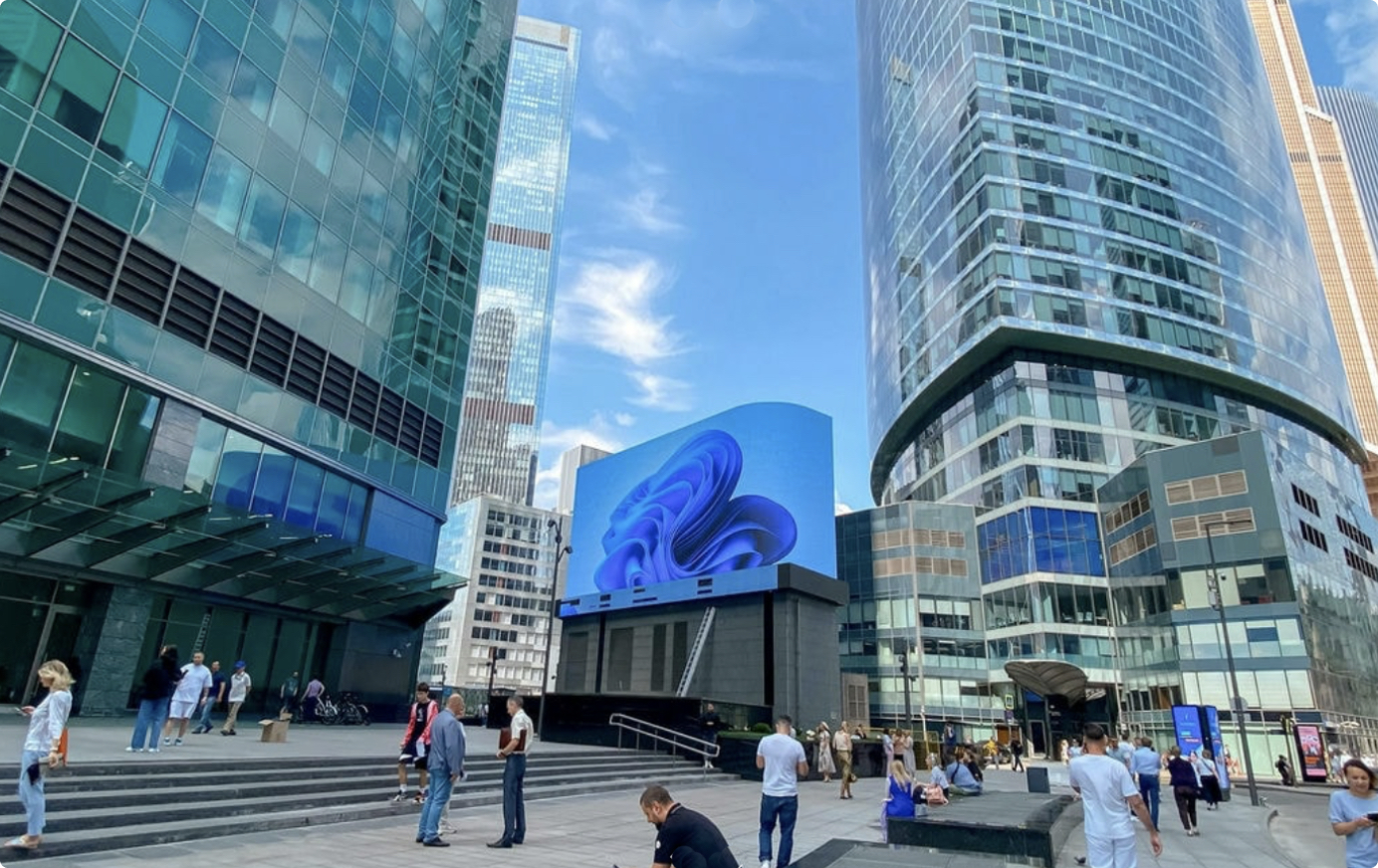
Source: High Lights.City
All innovations are proven by statistics. More than 2 million people visit the complex every month, 18 thousand live on the territory in modern apartments, including popular bloggers, 50 thousand work, and about 600 thousand people visit the Afimall shopping center. With such a large coverage of the payable audience, brands need to try hard to get people interested in their products.
In addition to new forms, new strategies are gradually emerging. RMAA has been helping Genshin Impact with projects in Russia for several years. As a part of the global promotional story #ENDLESSJOURNEY, the client asked us to solve a multi-purpose image task, which included Indoor placement. We developed a plan, starting with the choice of locations and digital ad formats, then attracted the audience with a cosplayers' event and made a photo-video report that was included in the client's #ENDLESSJOURNEY promo.
All this shows that outdoor advertising projects become more complex every year. A reasonable question arises: is a DOOH campaign worth the effort? How to evaluate the effectiveness?
Big data in practice
Let's talk about the analytical side of the issue, which concerns the use of data from digital screens. How is this happening in practice in Russia?
"Initially, we chose our own way, having rejected imported software back in 2020, when it became too expensive and inconvenient to modify. That's why we didn't look at imported analogs, but started to modify our existing software to meet the needs of advertisers, which turned out to be more flexible and inexpensive." - said Marina Surygina, director of digital strategy and marketing at Russ, in an interview to Kommersant.
Over the past two years, Russian outdoor advertising operators have significantly expanded their data collection capabilities and now process more than 100 million records daily. These records may consist of users' MAC addresses, which serve as a unique identifier for the network adapter installed in mobile devices. They are collected using Wi-Fi sniffers, tools designed to intercept and analyze traffic on digital billboards. However, this method is not so much in demand now due to some problems with connecting users to random Wi-Fi networks.
Therefore, in addition to MAC addresses, operators use GPS and geo-sensing technologies to obtain additional information.
The main focus of audience information gathering is on compiling socio-demographic profiles, including gender, age, and income, as well as user interests and preferences, purchase history, and places visited. These efforts aim to improve advertising strategies by connecting this data to complementary databases. This linkage allows detailed data to be allocated to specific audience actions: in-app purchases, responses to calls to action (CTAs), and offline shop visits.
In addition to all of the above, we can add a relatively new technology called real-time data collection. Thanks to it, there are ways to adjust the content on the screens according to the current weather conditions and traffic. All this allows advertisers to create more personalized DOOH campaigns. For example, a coffee brand has two visual solutions and can broadcast one in cold weather and the other on a hot day.
Whichever method or mix of collection techniques is used, the information then diverges into three main areas of work. The first is measuring average audience volume (note - including for programmatic buying). The second is the earlier planning of advertising campaigns for subsequent periods. The third is the evaluation of campaign results in analyzing the behavior of different audiences that saw the advertisement.
As we can see, DOOH advertising has become not just a 'beautiful' visual tool for broadcasting dynamic images, but also an analytical one. Further progress in outdoor advertising is emphasized by the strategic use of Big Data to improve the effectiveness of ad placements.
With many projects in outdoor advertising in its portfolio, RMAA has drawn its own conclusions about performance. Any campaign, be it DOOH or Indoor advertising, requires systematicity. Otherwise, the project realization time can be delayed at the stage of choosing the right location. In this case, we work with our own catalogs of outdoor advertising objects in Russia and CIS to provide each client with access to the most attractive locations as soon as possible after their request.
The future of DOOH in Russia looks very promising. As technology develops, we can expect the role of DOOH advertising in brand promotion strategies to become even more significant. If now, in the present time, you already have a project you would like to implement, fill out an application form or write to our manager.
RMAA experts will keep you in the loop. Subscribe to our blog to have access to up-to-date figures and news from the world of digital.
Join 2,000+
of your Peers!
You will be the first to know about Russian marketing insights, news and updates from our agency. Stay tuned!
Get our latest articles delivered to your email inbox and get our exclusive White Paper
"A media buyer's quick guide for effective work in Russia"
for FREE!
How does the Media Buying Market in Russia Work?
Navigating the Media Buying System in Russia

Ready to partner with the specialists in Russian marketing and advertising?
About the Author
Expert in Media Buying. Julia specializes in optimizing and executing strategic media placements across Russia & the CIS region.
Join 2,000+ of your Peers!
Get our latest articles delivered to your email inbox and get our exclusive White Paper "A media buyer's quick guide for effective work in Russia?" for FREE!
You will be the first to know about Russian marketing insights,
news and updates from our agency.
Stay tuned!
We're updating our website's design step by step, so some pages may look different. Thank you for your understanding.
Got it














